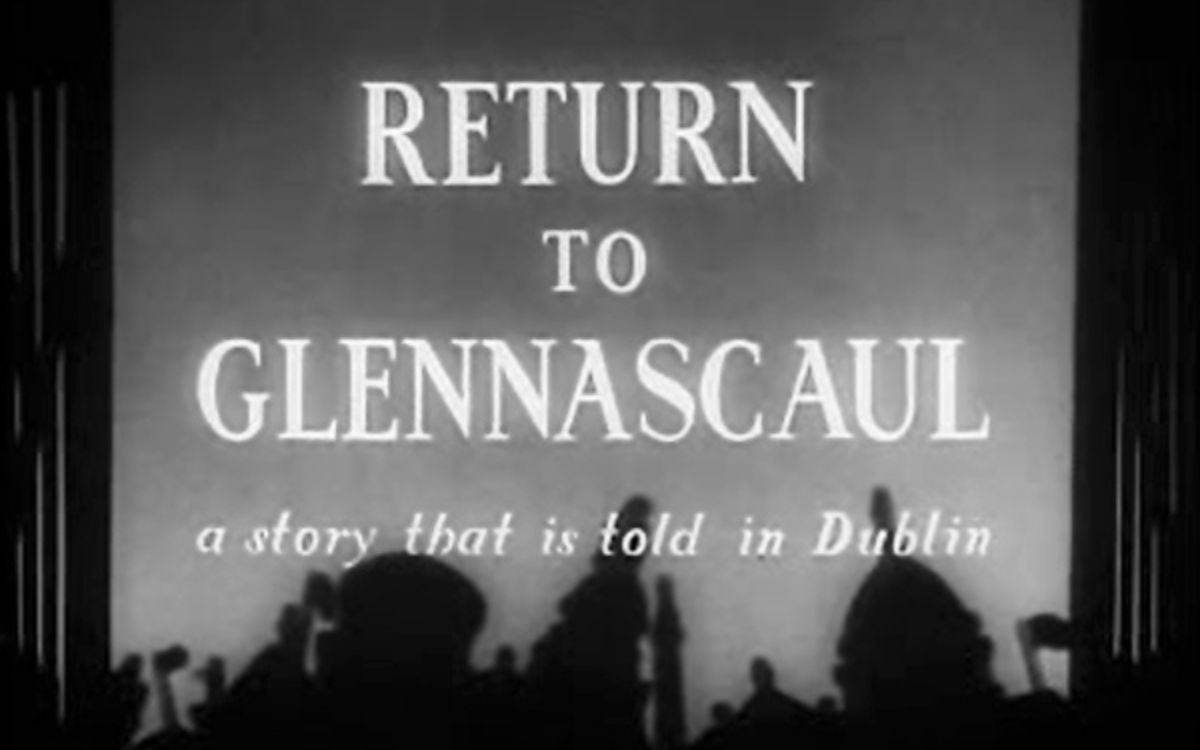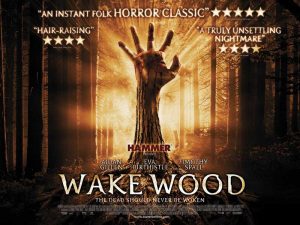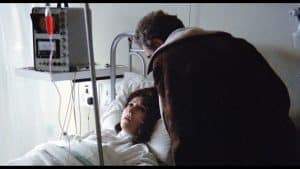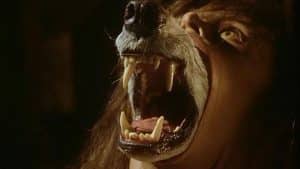Orson Welles takes a break from filming to tell a “tall tale” of Irish ghostly hitchhikers. ANN MASSEY reviews Return to Glennascaul 1951.

TITLE: Return to Glennascaul
RELEASED: 1951
WRITER: Hilton Edwards
DIRECTOR: Hilton Edwards
CAST: Orson Welles, Michael Laurence, Shelah Richards, Helena Hughes, John Dunne, Isobel Couser, Ann Clery
Return to Glennascaul 1951 Review
Return to Glennascaul 1951 is also known as Orson Welles’ Ghost Story and is set in Dublin, Ireland. The idea began in Italy where Orson Welles was filming his major project of 1951, Othello. Selected for the role of Iago by Welles, was actor and friend Micheál Mac Liammóir, who also happened to be founder of the Dublin Gate Theatre with his partner, Hilton Edwards. With all the stops and starts of production, the two actors found plenty of time to chat about other projects.
Welles had been friends with both gentleman since they gave him auditions and he worked with some of their earlier productions through the Dublin Gate Theatre. During one of the many halts in the filming of Othello, Micheál broached the subject of the established film heavyweight assisting them both in the making of a short film based on an Irish ghost story written by Hilton.
As a thank you for their earlier support, Orson agreed. While the film itself is set in Dublin, Orson Welles filmed his parts on set in Italy, as well as recording his narration.
The Plot of Return to Glennascaul (Spoilers Warning!)
In a nod to Aristotle’s theory of mimesis, it begins on the set of Othello. A call for lunch break is heard and the actor begins to narrate an explanation of his role in what he describes as a”tall tale”. The silhouette of Mr Welles lights a cigarette, before the scene cuts to an open rural road in Ireland.
Orson Welles is behind the wheel at night, when he happens upon a stranded motorist at a crossroads. Our hero offers the man a lift and he hesitantly accepts. Welles’ new passenger recognises the acclaimed actor and they begin to make small talk. Admiring Orson’s cigarette box, it reminds him of the last time he came upon that crossroads about a year ago – thus the “tall tale” begins.
The actor fades away and we are cast back in the memory of the stranded motorist, who we learn is Sean Merriman. The Orson Welles narration continues, as we learn the passenger had been stopped at that very crossroads by two women, flagging him down for a lift, asking to be dropped to their house, Glennascaul.
Over dramatic harp music, the gallant hero is invited in for a nightcap to warm him in the cold, wet night by the two ladies, a mother and daughter, which he duly accepts. Our helpful narrator lets us know that the house name actually means Glen of the Shadows.
Sean is clearly smitten with the daughter, while her mother puts the fear of God in us with seemingly innocent chatter. The mother’s chilling voice is the perfect pairing with her severe face lit up in the dark shadows of the house, by a lantern she is carrying with dramatic effect.
As they step into the drawing room, the ominous ticking of a clock kicks in and our narrator tells us the man was feeling more uneasy. The daughter picks up his cigarette case to admire, while the hints of something being not quite right begin to spill out. There are links between their pasts that entwine, Sean’s uncle from overseas and the oriental pieces adorning Glennascaul. The daughter reads aloud an inscription on the case, to Sean’s uncle from a past love called Lucy.
Merriman is startled by the chime of the clock at 1am and takes his leave. As he learns he is in the company of the Campbell family as they say goodbye, he promises to return. Out on the road, Sean realises he has left his cigarette case behind and turns back to claim his family heirloom.
He had only been gone a few minutes, yet the gate was rusted shut and the garden overgrown. Convinced at first he was at the wrong property, Sean saw a for sale sign and the following day enquired at the auctioneers, discovering it was indeed, Glennascaul House which had been unoccupied for years and the house was owned by Mrs Campbell and her daughter, Lucy.
Sean takes the keys and enters Glennascaul, walking through the decaying house in shadow, hints of what once had been, to him, just an evening before, but evidence proving years of abandonment. Entering the drawing room, it has been cleared of all furniture, just the shapes of shelves and the outline of a grandfather clock marked against the wallpaper.
Looking down, the anxious man sees his footprints across the floor, his cigarette case on the mantelpiece. A phantom clock chimes and the terrified Sean tears out of the house, a ghostly voice carrying through the hall, begging him to not leave.
A spooked Orson Welles pulls over as they reach Sean Merriman’s house and Welles hastily declines the offer to come in for a nightcap. Before he departs, Sean points out to Welles that the ghostly Lucy he met, was his uncle’s long lost love, as revealed on the cigarette case inscription. As a nervous Orson Welles drives along the street, two women try to flag him down for a lift, to which his terrified response is to veer sharply and drive off at breakneck speed.
Outraged, the very much living women begin to walk in the rain, disappointed and a bit disbelieving at the actions of the film star they had recognised!
What seems to have started out as a blatant advertising campaign for Orson Welles’ Othello, soon becomes a gripping ghost story, the kind told by candlelight in pubs all over Ireland. While the characters were frightfully proper and devoid of any Irish character or charm, it had little impact on the story itself and in some ways, enhanced the creep factor, the humorous twist at the end being typical of any Irish story of this nature.
If you have ever watched “The Veil”, the 1958 American supernatural series, which sees Boris Karloff introducing stories from “beyond the veil,” you can instantly see this short film is exactly where they got the idea from. In fact, I distinctly remember watching one of them that followed a very similar storyline to this!
Return to Glennascaul runs for just over 22 minutes and that is all it needs. It shows that you don’t need fancy effects, gore or to have an epic run time in order to make a good horror/supernatural film that holds an audience in suspense.
Without Orson Welles it is unlikely the movie short would have seen the light of day, however, as a production, the movie giant wasn’t needed to make the piece work.
Is it a unique storyline? No it isn’t. Roadside ghosts and vanishing hitchhikers are bordering on the cliché when it comes to horror movies and stories of Irish roadside ghosts are plentiful. The thing is, you forget the cliché while absorbed by this “tall tale,” drawn in to how easily it could happen and making a mental note to lock the car while driving and perhaps not stopping for stranded motorists.
Clearly I am not the only one to feel this way, as the film was nominated for an Oscar in the Best Short Subject category.
So sit down with a nightcap, by a crackling fire or candlelight, and spend 22 minutes stepping back in time to see how a short ghost film should be made.
Have you seen Return to Glennascaul 1951? Tell us your thoughts in the comments section below!






Just watched this little tale. It was excellently done; although I had guessed the way the story was heading well before the end.
There’s also an interesting aside in Welles’ dialogue for the keen-eyed viewer, at the point where one of the women says there must be something wrong with the car’s distributor cap and he immediately replies “yes, I’ve had a little trouble with distributors myself…”, a thinly-veiled reference to the way the big money men arsed up the ending of his ‘magnum opus’ The Magnificent Ambersons. Or at least that was HIS take on it…